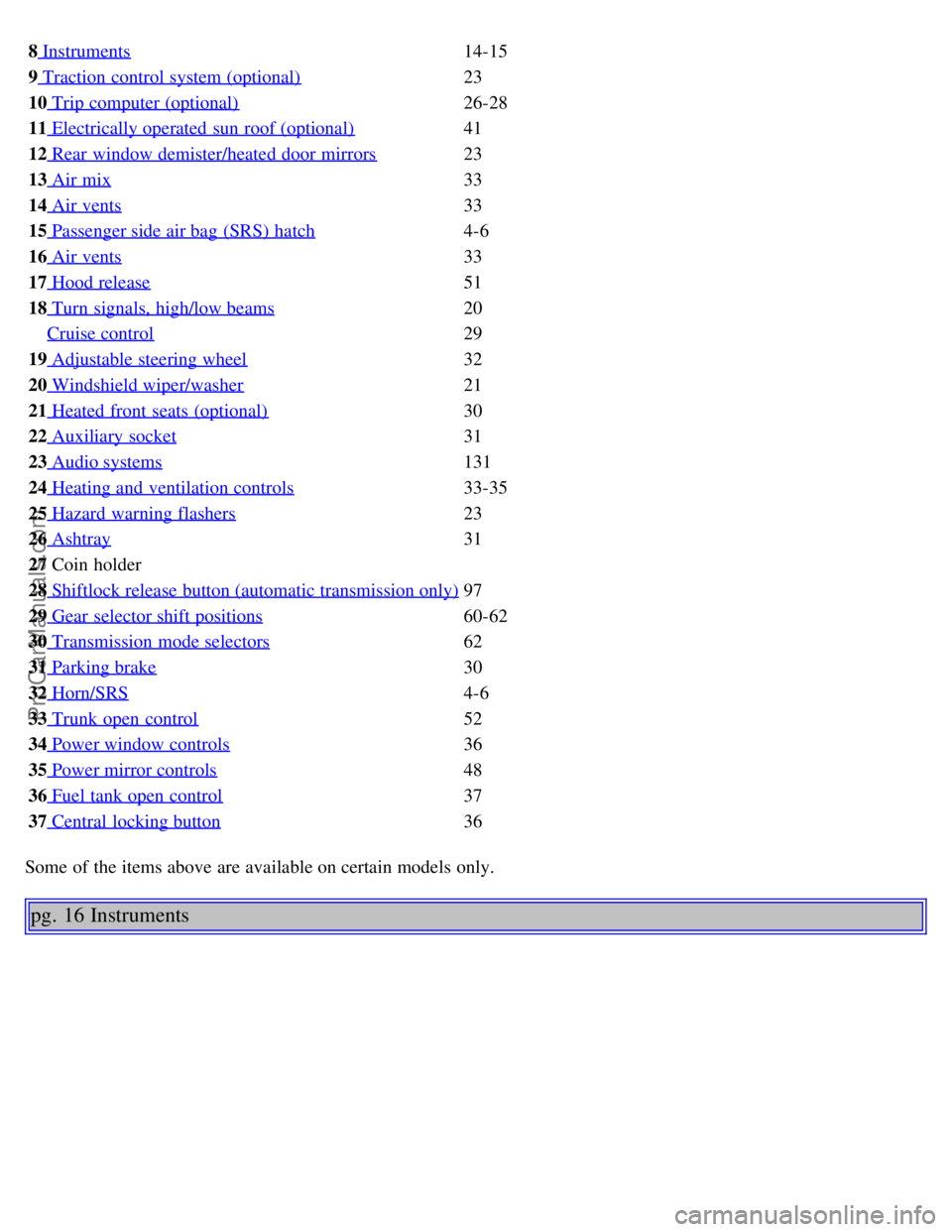traction control VOLVO C70 1999 Owners Manual
[x] Cancel search | Manufacturer: VOLVO, Model Year: 1999, Model line: C70, Model: VOLVO C70 1999Pages: 39, PDF Size: 0.64 MB
Page 9 of 39

8 Instruments14-15
9 Traction control system (optional)23
10 Trip computer (optional)
26-28
11 Electrically operated sun roof (optional)
41
12 Rear window demister/heated door mirrors
23
13 Air mix
33
14 Air vents
33
15 Passenger side air bag (SRS) hatch
4-6
16 Air vents
33
17 Hood release
51
18 Turn signals, high/low beams
20
Cruise control
29
19 Adjustable steering wheel
32
20 Windshield wiper/washer
21
21 Heated front seats (optional)
30
22 Auxiliary socket
31
23 Audio systems
131
24 Heating and ventilation controls
33-35
25 Hazard warning flashers
23
26 Ashtray
31
27 Coin holder
28 Shiftlock release button (automatic transmission only)
97
29 Gear selector shift positions
60-62
30 Transmission mode selectors
62
31 Parking brake
30
32 Horn/SRS
4-6
33 Trunk open control
52
34 Power window controls
36
35 Power mirror controls
48
36 Fuel tank open control
37
37 Central locking button
36
Some of the items above are available on certain models only.
pg. 16 Instruments
ProCarManuals.com
Page 21 of 39

well on the government course as a tire graded 100. The relative performance of tires depends upon the actual
conditions of their use, however, and many depart significantly from the norm due to variation in driving habits,
service practices and differences in road characteristics and climate.
TRACTION
The traction grades, from highest to lowest, are AA, A, B, and C, as measured under controlled conditions on specified
government test surfaces of asphalt and concrete. A tire marked C may have poor traction performance.
WARNING! The traction grade assigned to this tire is based on braking (straight-ahead) traction tests and does not
include cornering (turning) traction.
TEMPERATURE
The temperature grades are AA (the highest), A, B, and C, representing the tire's resistance to the generation of heat
and its ability to dissipate heat when tested under controlled conditions on a specified indoor laboratory test wheel.
Sustained high temperature can cause the material of the tire to degenerate and reduce tire life, and excessive
temperature can lead to sudden tire failure. The grade C corresponds to a level of performance which all passenger car
tires must meet under the Federal Motor Safety Standard No. 109. Grades B and A represent higher levels of
performance on the laboratory test wheel than the minimum required by law.
WARNING! The temperature grade for this tire is established for a tire that is properly inflated and not overloaded.
Excessive speed, underinflation, or excessive loading, either separately or in combination, can cause heat buildup
and possible tire failure.
Contents | Top of Page
ProCarManuals.com